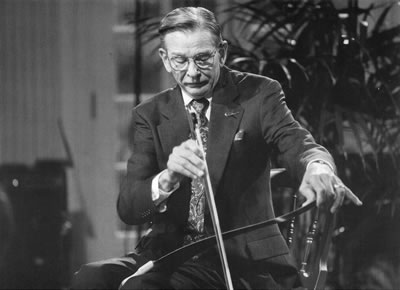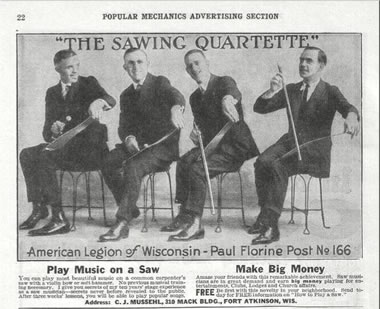
| Legendary multi-instrumentalist and dulcimer maker, Homer Ledford (1926-2006) playing the Musical Saw at the Kentucky Governor's Mansion in 1997 |
Listen to classic saw playing and info by Homer Ledford:
 Homer discussing playing techniques Homer discussing playing techniques
 A bit of "My Old Kentucky Home" A bit of "My Old Kentucky Home"
 Sweet Hour of Prayer, recorded in 1973 Sweet Hour of Prayer, recorded in 1973
|
To create a note, the player bends the blade into an S-curve. The parts of the blade which are curved are dampened from vibration, and do not sound, while at the center of the S-curve a section of the blade remains relatively flat. This is called the "sweet spot" which vibrates across the width of the blade, producing a distinct pitch. The sound is created by drawing the bow across the back edge of the saw at the sweet spot, or by striking the sweet spot with a mallet. Harmonics can be heard by playing at varying distances on either side of the sweet spot. The sawyer controls the pitch by adjusting the S-curve, making the sweet spot travel up the blade (toward a thinner width) for a higher pitch, or toward the handle for a lower pitch. Sawyers can add vibrato by shaking one of their legs, or wobbling the hand that holds the tip of the blade. When a sound is produced, it can sustain for quite a while, and can be carried through several notes of a musical phrase.
 Listen to a sample of Natalia Paruz playing the saw Listen to a sample of Natalia Paruz playing the saw
Though regular wood cutting saws were used (and some still used today), in 1919 Clarence Mussehl began perfecting the manufacture of the instrument. His innovations included using a special steel which was much more malleable and gave the plaintive tones more sustain and vibrato.
Through using thinner steel and experimenting with the width Mussehl was able to create a saw capable of producing approximately 16 to 20 notes. It was in 1921 that he began selling them commercially for the express purpose of playing music. During the peak of the Musical Saw craze, sales of the saw averaged approximately 25,000 per year.
As playing the saw requires a strong left hand, most players were men, though one well known lady saw player was actress Marlene Dietrich. She has played the saw at her performances for the soldiers during WWII, in a movie, on radio, and for friends at parties.
Web Resources:
Natalia Paruz's website, a great resource about the Musical Saw
& other instruments she plays: www.sawlady.com
Homer Ledford information site: www.homerledford.com |

One of many Musical Saw advertisements from the 1920s |
|
|
| Musical Saw |
Though some consider the Musical Saw an American folk musical instrument believed to have gotten its start somewhere in the Appalachian Mountains in the 19th century, the origins of the musical saw are actually not confined to one country. Some sources state the saw was invented in Argentina, or Russia. Most of what we know today is about Europe, but it is believed that saws were played in all continents without the people knowing of other people doing so in other places. Carpenters and lumberjacks all over the world discovered that their tool could make sounds, thus, no country can really claim ownership over the invention of making music with a saw.
Saw playing probably started at the end of the 17th century, when saws were mass produced with pliable steel blades.
The pioneers who couldn't afford bringing musical instruments with them to America brought tools for building houses, etc. Thus saw playing became popular in the USA at a time when there weren't other instruments easily available. During the 19th century (and probably before) many priests played the saw during church services. Later, the saw became a staple of Vaudeville shows.
The saw is generally played seated with the handle squeezed between the legs, and the far end held with one hand. It is generally played with the teeth facing the body. In the early 20th century the Musical Saw began to get very popular in America and Europe as well. It is also known as the Singing Saw, as it produces a very pure ethereal tone, and can sound similar to a woman's high singing voice.
The Musical Saw also sounds a bit like the Theremin.
Theremin virtuoso Clara Rockmore said that when Leon Theremin was working on inventing the theremin, the musical saw was very popular (in Vaudeville) and that he was aiming at recreating the sound of the saw electronically.
Musical saws have been produced for over a century.
In the early 1900s, there were over ten companies in the United States alone manufacturing saws. These saws ranged from the familiar steel variety to gold-plated masterpieces. However, with the start of World War II the demand for metals made the manufacture of saws too expensive and many of these companies went out of business, and only a few companies exist today.
The Future of the Musical Saw
The Musical Saw is still played today by a number of people, with festivals and gatherings held around the world. One of a number of notable saw players is Natalia Paruz, affectionately known as the "Saw Lady". Taking the Musical Saw to new heights and to a professional musical level, Natalia has performed with the Israel Philharmonic Orchestra, the Westchester Philharmonic Orchestra, the Royal Air Moroccan Symphony Orchestra and at Lincoln Center's Avery Fisher Hall with PDQ Bach composer Peter Schickele. She's also made many television appearances and can often be heard bringing her music directly to the people by playing in New York subways.
|
| At home in the orchestra or playing in the New York Subways, Natalia Paruz brings her music to the people. |
|
|
